Article and all photos by Joe Mock, BaseballParks.com
All rights reserved
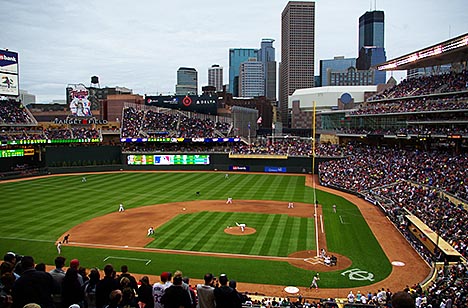 |
In 1994, the Twins surveyed the baseball landscape and didn’t like what they saw. They’d seen Toronto, Chicago (southside, of course), Baltimore, Cleveland and Arlington build new ballparks, and in each case, the teams playing in these new facilities saw a significant jump in their revenue streams. Being a small-market team, the Twins concluded they needed a new place to play if they were going to be able to compete in baseball’s new economics.
| Ballpark Stats |
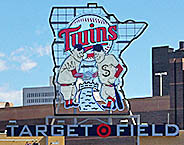 |
| Team: The Minnesota Twins |
| First game: April 12, 2010, a 5-2 win over the Red Sox |
| Capacity: 39,504 |
| Architect: Populous (formerly called HOK) |
| Construction: Mortenson |
| Price: $440 million for design and construction; $545 million including infrastructure changes |
| Home dugout: first-base side |
| Field points: east |
| Playing surface: Kentucky bluegrass |
| Betcha didn’t know: The ballpark covers about 12 acres, but the actual plot of land on which it was built is only about eight acres |
What ensued was eleven years of often acrimonious negotiations, and many attempts and failures to pass legislation to construct a new ballpark. All along, the Twins maintained they had to have a retractable roof because the Minnesota weather in the spring and fall wasn’t conducive to outdoor baseball.
You might recall some of the twists and turns of the Twins’ saga, including a legitimate threat that they would move to North Carolina and the very real possibility of the franchise being “contracted” along with the Expos prior to the 2002 season. When the Minnesota legislature finally passed a bill authorizing an increase in the sales tax in Hennepin County to generate money for a new ballpark, the Twins were ecstatic. There were only two problems: the amount allocated for the park failed to include money for a retractable roof (a pricey item at about $100 million); and the bill specified an exact location for the new facility.
The Twins didn’t want to wait another 11 years for a more favorable bill to come along, so they quickly dropped their demands for a retractable roof, thereby sealing the deal. However, the ballpark site itself had two major problems: it was privately owned; it really wasn’t large enough to hold a Major League stadium.
Months of negotiations with the owners of the site failed to yield a sale, and the issue ended up in court. Finally, the Twins agreed to cough up additional funds for the acquisition, and suddenly a deal was made. But the site, covering less than eight acres, was still too small. Even the architects hired to design the ballpark said it wasn’t workable. After all, they felt 12.5 acres was the minimum size for a big-league ballpark.
However, those folks up north can be very clever. The Minnesota Ballpark Authority was successful in convincing Burlington & Northern Railroad to move some train tracks, which stretched the perimeter of the site. HOK (now known as Populous) employed some cutting-edge engineering techniques that allowed the construction to rise upward and outward.
And before you knew it, what started as a postage-stamp-sized seven-and-a-half acres of land ended up holding about 12 acres worth of a first-class ballpark. And in April of 2010, the Twins were playing outdoor baseball in Target Field. In fact, the photo at the top of this page was the first pitch thrown by a Twins hurler in their fancy new facility.
But what about the site’s surroundings? And how did the seating bowl turn out? Did the limited size of the site cause the seating bowl to be cramped with poor sight lines? And are Twins fans enjoying themselves at their new outdoor, baseball-only playground? Let’s break it down in our usual step-by-step manner.
The Setting
As the years rolled by and the Twins’ front office continued to plead its case for a new park, lots of different locations were suggested for a new baseball-only facility. Because the Metrodome in downtown Minneapolis was going to continue to house the Vikings and University of Minnesota, a new park couldn’t be built on its site. The Twins favored a scenic location along the Mississippi River just to the north of the Metrodome, but eventually the new Guthrie Theater was built there instead.
The team was willing to move to downtown St. Paul — the other “twin city” — or an outlying suburb. There was the well-publicized attempt to convince voters in North Carolina to approve a new stadium for the Twins in the Greensboro/Winston-Salem area, but that failed. The logic of staying within Minneapolis seemed to emerge again and again, and once the state legislature got serious about helping, a location on the western edge of the downtown business district came to the forefront. It contained a fairly unattractive parking lot, made all the more unappealing because it was in the shadow of the “HERC,” more commonly called the “garbage burner” by locals.
The Hennepin Energy Recovery Center or HERC is located directly across railroad tracks from the ballpark, on its western side. Here, truckload after truckload of trash is brought in to be incinerated — hence the locals’ nickname of “garbage burner” for the HERC. When I visited the ballpark site immediately after it was selected, I drove around to the back of the HERC facility to take some pictures. It didn’t smell very nice. However, part of the infrastructure costs for the ballpark project was to fundamentally change the way the trucks deliver the trash to be burned. They used to enter through large openings on the ballpark side of the facility. Not any more. There are new entry points for the trucks to use, and because the bad smell emanates from the trash before it’s burned and not after, you don’t have to hold your nose when attending a Twins game.
So I guess you could say that the new park passes the “smell test.”
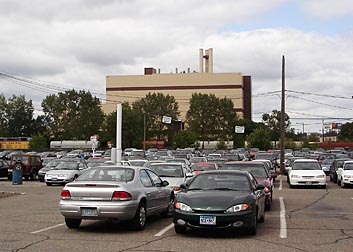 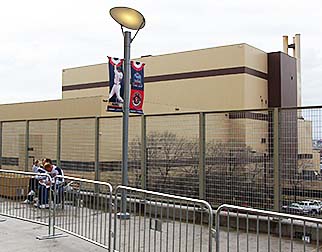 |
The photo on the left side above was taken in September 2006 from the parking lot that is now Target Field. It is looking west toward the HERC. The smokestacks can be seen beyond the main building, and the area didn’t smell very nice. The right-hand photo is also of the HERC, taken from the outer concourse of the new ballpark. The area where trucks used to deliver the garbage is now completely closed. In fact, the small parking area that was at the base of the building is now a neatly manicured bed of shrubbery.
But what about the rest of the new ballpark’s neighborhood? In my opinion, the park is located on the periphery of downtown, poised between high-rise hotels and the basketball arena known as the Target Center on one side, and a neighborhood called the Warehouse District on the other. The downtown side is certainly a bustling business district, with plenty of restaurants and places to stay … but it really wasn’t easy to walk to the ballpark site a few years ago. That’s because the site was on the west side of Interstate 394, while downtown and the Target Center are on the east side. Therefore, it became critical that the architects at Populous find a way to “bridge” Target Field to downtown. “We had to build the city to get the ballpark to happen,” joked Populous senior principal Earl Santee. The key solution to the problem was the creation of Target Plaza, which was built over I-394 and connects North 6th Street on the north side of the Target Center and North 7th Street on the south side to the main entryways of the ballpark. I’ll have more on this fantastic plaza in the next section.
What about the ballpark’s neighborhood on the side opposite of downtown? The Warehouse District is an interesting area, in that there are many old, low-rise buildings there — some abandoned, some still used as warehouses and light industry. But there’s also somewhat of a buzz about the area, in that some nightlife exists there, and it appears that the arrival of the ballpark will probably spur some additional eateries and clubs to open here, just as happened in St. Louis on the southern side of new Busch Stadium when it opened. However, here in the Warehouse District of Minneapolis, there’s also quite a bit of “gentrification,” in that new condos and retrofitted loft apartments have sprung up.
As a matter of fact, when I came for the weekend to attend the park’s two exhibition games on April 2 and 3, 2010, my hotel was in the of the heart of this District. I never needed to move my car, as I simply walked the five blocks to the ballpark. In addition, I was able to find plenty of delis and restaurants within two blocks of the hotel. During my walks to the ballpark, I noticed that some smart fans elected to park in garages and lots in this neighborhood, and by so doing they avoided long lines of cars entering and (especially) exiting the three main parking garages adjacent to the ballpark on the downtown side. By the way, you’ll need to get used to the fact that Minnesotans typically refer to parking garages as “ramps.” Therefore, if you plan to park as close to Target Field as possible, you’ll be in either Ramp A, Ramp B or Ramp C.
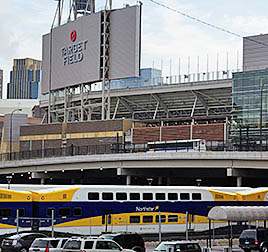  |
By no means do you need to drive to watch the Twins play, though. Public transportation is phenomenal here — perhaps better than at any new baseball stadium built in years. The Twins like to boast that Target Field is the first ballpark with a commuter-rail station built into it … and indeed, in the western corner of the park’s main structure are elevators that take you down to the Northstar Commuter Rail station on the ground level below (above left). Note, though, that this service does not operate for every home game.
Directly next to those elevators is a platform (bottom left-hand corner of the photo on the right above) for the city’s Hiawatha Light Rail Transit system, which was extended from the middle of downtown to the ballpark. You can now ride the Hiawatha line from the Minneapolis-St. Paul Airport and Mall of America on the southern edge of the city’s metro area all the way to Target Field. There are also 20 different bus routes that stop at or near the ballpark, and many of them drop you off in a covered area directly next to Gate 3 behind center field.
If you do drive, you’ll find that Target Field has excellent highway access, as a main east-west Interstate, I-94, runs just west of the park, and I-394 brings fans from the southwest directly to the parking garages — er, ramps — adjacent to the field (in fact, part of Target Plaza, adjacent to the ballpark, was built directly over I-394). The Twins also like to point out that in addition to the 7,000 parking spaces in Ramps A, B and C, there are another 25,000 spaces in downtown Minneapolis, 10,000 of which are less than a 15-minute walk to the park.
And I’d be remiss if I didn’t point out that the Cedar Lake Bike Trail will also bring bicyclists directly to the ballpark, and once there, you’ll find about 400 spaces for bikes.
So Target Field’s location is certainly accessible … but you do have to marvel at the fact that the original plot of ground selected for the park is so doggone small!
The Exterior
I love the intriguing location of Target Field, and I love just about everything inside the park. The exterior? Well, I’m not as crazy about it.
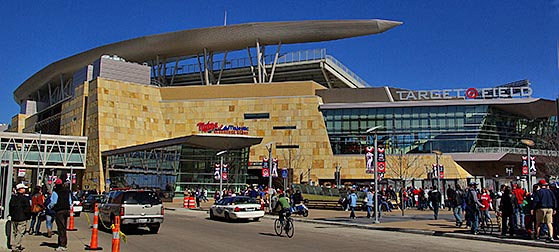 |
I understand what the architects were trying to achieve with the exterior. They wanted a very “natural” look with limestone squares mined in Minnesota and natural wood covering the pedestrian ramps inside the park. It’s a worthwhile objective, but for my taste, it makes for a busy exterior — especially when you factor in the unique features that jut out from the otherwise even planes of the outer walls.
First, let’s talk about the limestone. When you use natural building materials that come from nearby, you gain important points when you attempt to have your facility judged for LEED “green” certification. Indeed, Target Field passed the certification process with flying colors, gaining 36 points, allowing it to achieve Silver status. That’s a better outcome than any ballpark ever built, making Target Field “the most sustainable outdoor baseball facility in the country,” according to a Populous press release. “Earning LEED Certification was a priority for Hennepin County from the time we undertook the ballpark project four years ago,” said Mike Opat, Chairman of the County Board.
The limestone blocks (left photo below) cover about 60% of the park’s exterior, which is all well and good … but the aspect of it that I don’t like is that the blocks are so dissimilar from each other. The wide variation in color and markings of the blocks gives the facility somewhat of a checkerboard look. Natural looking? Without a doubt. Pleasing from an aesthetic point of view? Not so much.
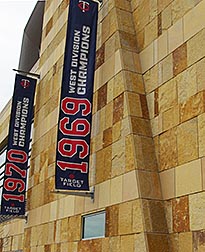 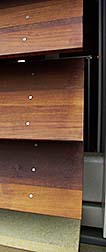 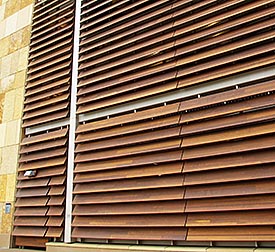 |
Further complicating the busyness of the exterior are the wood panels that separate the outside world from the pedestrian ramps just inside the outer wall of the park (above right, with a close-up in the middle above). Again, this is great for the environment because in other stadiums, you might have metal or plastic panels making up this outer wall where the ramps are located … but to me, it is a little incongruous when directly next to the limestone.
By the way, I’ve read that the type of wood used is called ipe (pronounced “ee-pee”),which is a hardwood from Brazil. Doesn’t it defeat the purpose of using local building materials for your “green” stadium when hundreds of linear feet of wood panels come from South America?
And while I’m griping, I’m not in love with the two glass-and-steel structures that jut out from the upper level of the park. I really like the spaces that they create on the club level inside the stadium, but they stick out in an odd way when you look at them from the outside. Those two areas are the Metropolitan Club down the first-base line between Gate 34 and Gate 29 (below left) and the 573 Bar behind home plate near Gate 14 (below right). The exterior of the Town Ball Tavern down the third-base line is another example of this, but not nearly as egregious. Yes, these protrusions are quite distinctive, but to me, they just don’t seem fit in with the rest of the exterior.
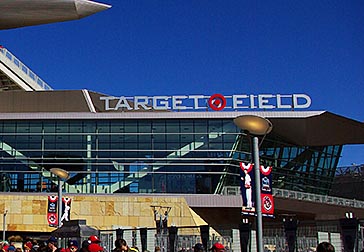 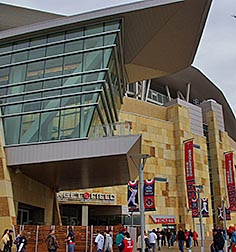 |
The gate numbers, by the way, can be quite confusing. The entryways are designated by numbers: 3, 6, 14, 29 and 34. If you’re a die-hard Twins fan, you’ve already figured out why: these are the uniform numbers that have been retired by the team. Number 3 is Harmon Killebrew. Number 6 is Tony Oliva. Kent Hrbek wore number 14 (this is the gate behind home plate). Rod Carew wore number 29. And the gate that is probably most heavily used is number 34, which is the number worn by the late Kirby Puckett.
And with that, I’m done complaining about the exterior. Everything else I have to say about the areas outside Target Field is very, very positive.
The “canopy,” the name given to the roof that covers most of the upper-level seats, is an element of the exterior that you simply can’t miss. In fact, I first laid eyes on it from the window seat of my plane as it was landing at the airport — and it was clearly visible from about 10 miles away through rain and fog. I’d say that is a distinctive roof! And at almost 67,000 square feet, it is the largest in the Majors … and, I might add, with its smooth curves and the fact that the lights are contained within its structure, it is undoubtedly one of the most attractive in baseball.
There are three huge mosaics set in the ballpark’s exterior wall along the North 5th Street side, near Gate 3. These were created by artist Craig David who lives in St. Paul, and one of them (below left) shows some of the key baseball figures in Minnesota’s past, including Native American Chief Bender, enshrined in Cooperstown, and Toni “Tomboy” Stone, a black woman from St. Paul who competed in the (men’s) Negro Leagues in the 1950s.
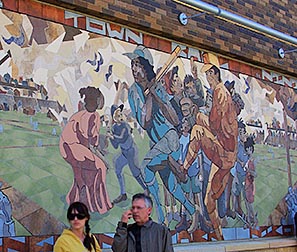 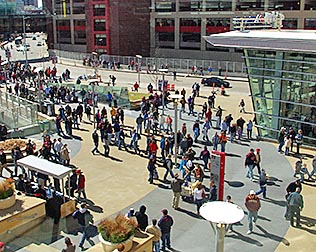 |
Target Plaza, the expansive area that connects the downtown business district to the ballpark, is fabulous — and represents quite a few square feet that weren’t above the original plot of ground designated for the park. That’s because it was built over the travel lanes of I-394. The photo on the right side above shows only a small portion of the plaza. This part, interestingly, is directly over the Interstate.
This plaza has quickly become a favorite gathering place for fans before and after games, and with good reason. There is so much to do and see here that most fans will wander through the plaza several times before they notice all that it has to offer.
Hands down, my favorite feature of the plaza area is the “wind veil” that covers the entire side of Parking Ramp B — all 285 feet of it. I’ve never seen anything like it, and it might be the second most mesmerizing feature at any ballpark, after Kauffman Stadium’s famous fountains. The actual name of this piece of art is “The Wave,” and it is made up of thousands of reflective metal panels (below left), each about the size of a baseball card. As the wind blows — and it blows a great deal here because this open area between buildings acts as somewhat of a wind tunnel — the panels flip around allowing you to see the patterns in the wind currents. Once you notice it, it’s hard to take your eyes off of it. And it at night, it is illuminated by ever-changing colored lights at its base (below right). To say it is utterly spellbinding would be an understatement.
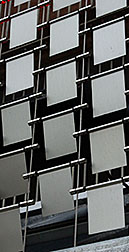 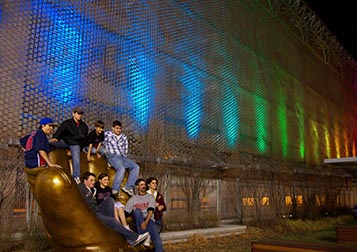 |
Along this wind veil is a huge bronze statue shaped like a baseball glove (foreground of above right). Called The Golden Glove, it pays tribute to the team’s desire to play superlative defense. Fans, though, view it more as a photo op, as many waited in line to be photographed sitting or standing within the glove. Perhaps its most noteworthy characteristic is where it’s located. You see, it is exactly 520 feet from home plate, which is the distance of Harmon Killebrew’s legendary blast at Metropolitan Stadium, which was located where the Mall of America is now in Bloomington. That home run is considered to be the longest in Twins history … and it was hit long before the age of steroids in baseball!
Speaking of Harmon, Target Plaza offers several other features that you’ll definitely want to examine, including bronze statues of Killebrew (shown below at the dedication of his statue. That’s Kent Hrbek between Harmon and the statue), Rod Carew and Kirby Puckett. There’s a very well done tribute to the area’s previous baseball facilities (below right), including the Metrodome, Met Stadium, Lexington Park where the Saint Paul Saints of the Triple-A American Association played prior to 1957, and Nicollet Park, home of the Minneapolis Millers, also of the American Association.
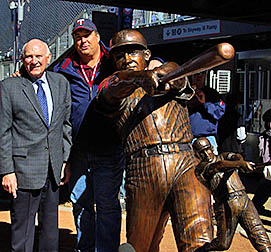 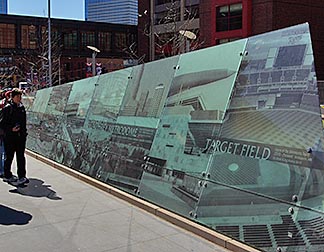 |
So I don’t really like the look of the limestone or the combination of building materials used on Target Field’s outer walls, but everything else regarding the park’s exterior is wonderful. Let’s now take a look on the inside of the park.
The Design
Again, the fact that a Major League ballpark was constructed on such a tight spot is remarkable. However, the bigger miracle is how many great features are crammed on top of Target Field’s footprint.
 |
In some respects, Target Field is the opposite of Citi Field and new Busch Stadium, both of which were also designed by HOK/Populous. In both the Mets’ and Cards’ parks, the footprint of the structure is enormous, but you still have a wonderful feeling of intimacy inside the seating bowl. In Minneapolis, there’s a tiny footprint but a refreshing feeling of spaciousness inside. This remarkable design and engineering feat was pulled off by the way the structure was built “up and out.” Dave St. Peter, the president of the Twins, told the Star Tribune that Target Field “forms a muffin, so to speak. It comes up and expands out.”
Let’s look at the ballpark level by level, starting with the bottom. And when I say “bottom,” I’m only referring to its location, not its quality.
The first thing you’ll notice when you decide to go to that level is that you have to take an elevator from the main concourse, which is understandable. What’s surprising, though, is that the main level is called “0” in the elevator, and the bottom level is “-2.”
The “negative two” level contains the clubhouses and workout rooms for the players, as you would expect. The Twins’ locker room, by the way, is 1,300 square feet larger than the one at the Metrodome. Also on this level is the Champion’s Club, the ultra-exclusive dining and seating area. The elegant dining area (below left) contains the Twins’ two World Series trophies, as well as an exceptional assortment of high-end dishes. You walk out into the seating area from the dining area to a section of 400 extra-large, extra-padded seats. The view you get from that section is phenomenal (below center), as the front row is only 45 feet from home plate. In the hallway between the dining and seating areas is a large window that allows you to watch Twins players using a batting tunnel (below right). This tunnel is right behind the Twins dugout, which is now on the first-base side of the field, after being on the third-base side at the Metrodome.
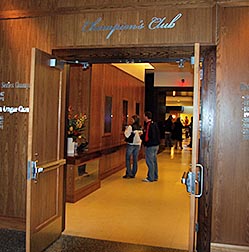 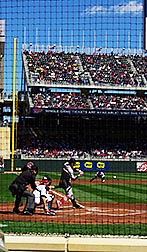  |
Back up on the main level, the first thing you’ll notice is how wide the concourse is, especially if you’d gotten used to the 22-foot-wide concourses at the Metrodome. Here, it’s 40 feet wide, which is 12 feet wider than the comparable concourse at San Francisco’s AT&T Park. Also, you can walk unimpeded all the way around the main level in Minneapolis, and you know how I love 360-degree concourses like this.
Another significant change from the Metrodome is that the seats at Target Field all face toward the infield … and speaking of seats, there are 39,504 of them at the Twins’s new place, which is almost 16,000 fewer than the Metrodome (although the capacity for most baseball games in the Dome was 45,423). That puts the Twins’ seating capacity in the same “ballpark” (sorry for the pun) as Pittsburgh’s and San Francisco’s showplace facilities. All of the seats in the main bowl are theater-type seats, while aluminum benches with backs exist in the outfield near each foul pole.
Two outfield seating areas on the main level deserve mention. One is the “Overlook” section, in which the front rows of the section actually extend over the field of play in right field by eight feet. Balls that land in these seats are a home run, but ones that bounce off of the facing of the section will be in play. This could be even trickier than it sounds, because the facing of the section has the same kind of limestone blocks as the exterior (right-hand photo below). The other is the Powerball Pavilion in right-center field (center shot below). The chairbacks of the seats in this section are made of wood. The Twins point out that no new stadium seats have been made of wood since the 1940s.
There are no fewer than 13 permanent concession stands on the main level, as well as at least a dozen moveable kiosks, many of them near the right-field foul pole.
 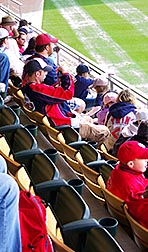 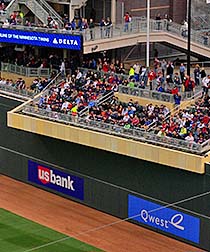 |
The Club Level is the next stop on our trip upward, and is it ever special! It’s too bad that many fans will never see it, because most of it is reserved for the 2,893 season-ticket holders in the Delta SKY360 Legends Club. Those special folks get to hobnob in a 32,000-square-foot lounge area that includes two atriums named for Rod Carew and Kirby Puckett (both of which feature images of their namesakes etched in wood; below right shot is of Carew) and the 573 Bar, so named because that’s how many HRs were hit by Harmon Killebrew in his career. Any season-ticket holder can eat in the Metropolitan Club, which is one of the most impressive areas in the entire stadium. This restaurant, which features floor-to-ceiling glass on three sides, is at the right-field end of this level (below center).
The Legends Club seats also have wooden chairbacks, but there’s a little more legroom here than in the outfield Pavilion. Down the third-base line are larger seating sections (with normal plastic backs) called the Skyline Deck. All of the seating sections in the main seating bowl of this level are identified by letters of the alphabet, while all other sections in the park carry numbers.
In the outfield areas of this level, you’ll find the double-decked Home Run Porch sections in left field, the Batter’s Eye section in dead center field, and the Twins’ version of Denver’s Rockpile, called the Grandstand, in right center field. The view from the Grandstand is shown below right.
 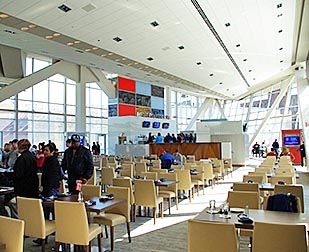 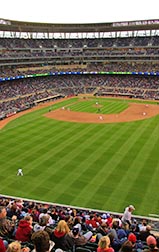 |
The uppermost level contains two seating areas, the Terrace on the same level as the upper concourse, and the View. The latter is physically separated from the Terrace so that the concourse is open to the field at many points, the same way the highest seats are at Citizens Bank Park in Philadelphia. And like in Philly, these top two seating sections are quite a bit steeper than the lower deck, as the shot taken from down on the field below (on the left) indicates.
The concourse on the top level isn’t as wide as the main level. At some points, it’s only 26 feet wide, and for sold-out games, it does get crowded.
There is a structure directly down the third-base line that is reminiscent of Petco Park‘s Western Metal Supply Company building, which was retrofitted with bars and a rooftop experience like those across the street from Wrigley Field. Although the structure in Minneapolis (below right) isn’t an old building that was retrofitted, it does provide a rooftop venue for groups or individuals to congregate. More on that in our next section. For now, suffice it to say that the team’s administrative offices are contained on its lower levels. Aesthetically, I really don’t like the fact that its Budweiser logo is so prominent, or maybe I should describe it as being “dominant.” I know that these kinds of logos are popping up in more MLB parks (Pepsi at Citi Field, Budweiser at Fenway, the huge Coke bottle at AT&T Park), but that doesn’t mean that I have to like it.
We also need to examine the canopy further. While we discussed what it looks like from the outside, I need to talk about its functionality for the interior. Yes, it contains the lights (below center), instead of the lights sitting on top of it (this is a huge move forward aesthetically). Not only that, the lights use new technology that makes them more efficient, so less energy is used and less heat is generated. Further, the outer shell of the canopy uses what Populous calls “solar reflective materials” that will help reflect the sun’s heat, rather than retain it. This will also keep the fans cooler in the summer, and its enormous size will keep many of them dry when it’s rainy.
The roof is only one of the many, many design elements that are classified as “sustainable.” One that really captured my fancy is the way rain and run-off from watering the field are captured in 12-foot-diameter cisterns that are buried under the park’s warning track. This water is then filtered and used to rinse off seating areas as part of the post-game clean-up. No other stadium has this sort of system.
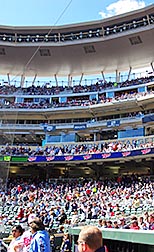 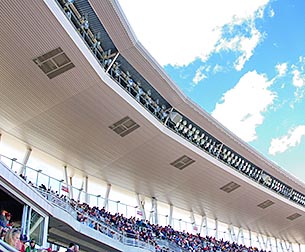 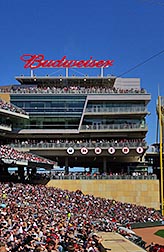 |
Speaking of the field, it is a marvel unto itself. The Kentucky Bluegrass sports turf is rooted in 10″ of a special mixture of sand and peat. Directly below that is a grid of hoses (40 miles worth) that carries water and glycol so the temperature of the field can be regulated from below all year-round. The HERC next door helps provide heat for this purpose. Beneath these hoses is a blanket of gravel that allows excess water to drain down into a 6-inch drainage pipe.
But the most important thing is that the green stuff on this field actually grows, which the springy surface at the Metrodome certainly didn’t.
The dimensions of the field, by the way, don’t vary all that much from the Metrodome, but where they differ, Target Field’s distances to the fences are shorter — thanks to the size constraints of the park’s site. The power alley in left center, for instance, is 377 feet, eight feet shorter than at the Dome. Interestingly, the right-field wall is only two feet closer to the plate in the Twins’ new home, but it has the same 23-foot-tall wall as at their old home. Thankfully, there isn’t a “Hefty bag” at the top of the wall at Target Field!
Overwhelmingly, the biggest difference between the size of the playing surface at the old and new parks is the foul territory. Populous calculated that the Metrodome had an ample 30,244 square feet of foul ground, whereas Target Field has only 22,042. Only five current MLB parks have smaller foul territories than the Twins’ new park, and that means that a number of foul pop-ups will now land in the stands that last year were falling into fielders’ gloves.
The batter’s eye is especially pleasing at the new park, as it is made up of black spruce trees from northern Minnesota. That certainly beats a dark blue or green screen hung above the center-field fence.
All in all, a spectacular design and construction job was done on Target Field. Its interior is inferior to none of the newer parks in the sport.
Went to Summerfest last weekend & it was great at Target Field. The ballpark is beautiful; people are respectful & nice for the most part. But of all the people you would think EMTs would be respectful & know how to get thru the crowd without endangering others. As we were leaving in the very crowded walkways, an EMT rudely says “I got to get thru” & pushes his way thru. We all were trying to get thru & if he announced he was an EMT & had an emergency, we all would make a way for him. I saw who he was & let him thru but he had difficulty with others. Then another one came up from behind & said the same thing & before I could move myself &/or my kids, she was pushing & shoving me & my young child like she was trying to climb her way thru the crowd. Please train these people better so that they do not do this to others again!!!!